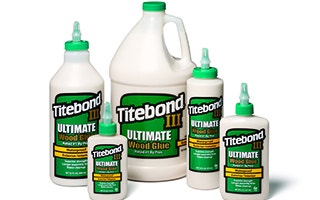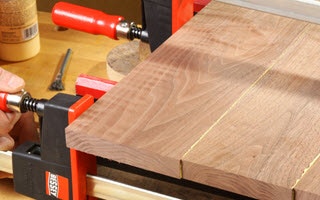Glue-Ups - How Long Do You Leave The Clamps On?

How long do you have to leave the clamps on a glue-up project? This Q&A segment from the Woodworker's Journal sheds some light on the subject. Thanks to our friends at WWJ for letting us share this advice from renowned woodworkers Michael Dresdner and Ian Kirby.
Woodworking Question - When I'm ready to clamp my gluedup panel, how tight is too tight? The directions on the Titebond® bottle says to allow the glue to set for 15 minutes. Does that mean at least 15 minutes or should you unclamp after that time so the wood can regain it's natural shape?"
Answers From The Experts
Michael Dresdner: If you are crushing or deforming the wood, it is too tight. All you really need is for the surfaces to be firmly in contact with one another. The 15 minutes is a minimum, and it certainly does not hurt to leave the wood in clamps until you are ready to machine it, or until the clamps get in your way or are needed elsewhere.
Ian Kirby: If you're clamping a mortise and tenon, a dovetail or a butt joint, you can see when the shoulder lines are closed—that's all the pressure you need. When you can't so easily see the joint line-say, two blocks face to face-enough pressure is when you squeeze out beads of the glue. But this goes to the question of how much glue do you use. A good rule of thumb is "as little as possible." You have to wet every surface and you should roll it where you can roll and brush or paddle elsewhere.
Brush it on and then try to brush it off, but wet every surface. The aim is to get the smallest line or bead of squeeze-out. Gobs of the stuff squeezing out doesn't help the joint, but it does make Titebond richer. The length of time glue can be stored before it deteriorates is called its shelf life. The amount of time you have to leave the clamping pressure on is call the closed clamping time. The time you have between starting to put glue on the parts and getting them into clamps is called the open clamp time.
Some glue makers strive to provide a product with a long open time and a short closed clamping time. For my money, a job that relies on glue to hold it together is worth more time, so I leave stuff in clamps a couple of hours. And about that last sentence: clamping shouldn't distort the work! If it does, you're clamping too tightly or using clamping blocks incorrectly. But yes, Titebond says you can take the clamps off, but you don't have to.

It's important to remember that clamping time for a joint to set is different than the time it takes before a joint should be under stress. Titebond recommends 24 of cure time for their PVA wood glues (typical yellow wood glue) before a joint is put under stress. If you read the instructions on the label of the glues and adhesives you use, and follow the advice above, you should be in good shape.
Keep the inspiration coming!
Subscribe to our newsletter for more woodworking tips and tricks


